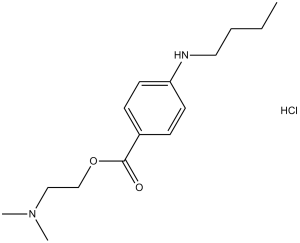This product is for research use only, not for human use. We do not sell to patients.

| Size | Price | Stock |
|---|---|---|
| 5g | $190 | Check With Us |
| 10g | $250 | Check With Us |
| 20g | $375 | Check With Us |
Cat #: V1247 CAS #: 136-47-0 Purity ≥ 98%
Description: Tetracaine HCl (also called Amethocalne; Butylocaine; Curtacain; Decicain; Gingicain; PantocaineM; Intercaine; Leocaine; Menonasal; Niphanoid), the hydrochloride salt form of tetracaine, is a local anaesthetic and a channel function allosteric inhibitor.
Publications Citing InvivoChem Products
Product Promise

- Physicochemical and Storage Information
- Protocol
- Related Biological Data
- Stock Solution Preparation
- Quality Control Documentation
| Molecular Weight (MW) | 300.82 |
|---|---|
| Molecular Formula | C15H24N2O2.HCl |
| CAS No. | 136-47-0 |
| Storage | -20℃ for 3 years in powder formr |
| -80℃ for 2 years in solvent | |
| Solubility In Vitro | DMSO: 60 mg/mL (199.5 mM)r |
| Water: 60 mg/mL (199.5 mM)r | |
| Ethanol: 30 mg/mL (99.7 mM) | |
| Synonyms | Amethocalne HCl; Tetracaine hydrochloride; Amethocaine hydrochloride; Butylocaine; Curtacain; Decicain; Gingicain; PantocaineM; Intercaine; Leocaine; Menonasal; Niphanoid; Tetracaine HCl. |
| Protocol | In Vitro | Tetracaine hydrochloride (Amethocaine hydrochloride) is used to alter the function of calcium release channels (ryanodine receptors) that control the release of calcium from intracellular stores. Tetracaine hydrochloride is an allosteric blocker of channel function. At low concentrations, tetracaine causes an initial inhibition of spontaneous calcium release events, while at high concentrations, tetracaine blocks release completely |
|---|
| Solvent volume to be added | Mass (the weight of a compound) | |||
|---|---|---|---|---|
| Mother liquor concentration | 1mg | 5mg | 10mg | 20mg |
| 1mM | 3.3242 mL | 16.6212 mL | 33.2425 mL | 66.4849 mL |
| 5mM | 0.6648 mL | 3.3242 mL | 6.6485 mL | 13.2970 mL |
| 10mM | 0.3324 mL | 1.6621 mL | 3.3242 mL | 6.6485 mL |
| 20mM | 0.1662 mL | 0.8311 mL | 1.6621 mL | 3.3242 mL |
This equation is commonly abbreviated as: C1 V1 = C2 V2
- (1) Please be sure that the solution is clear before the addition of next solvent. Dissolution methods like vortex, ultrasound or warming and heat may be used to aid dissolving.
- (2) Be sure to add the solvent(s) in order.




































